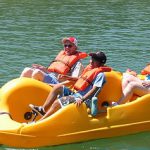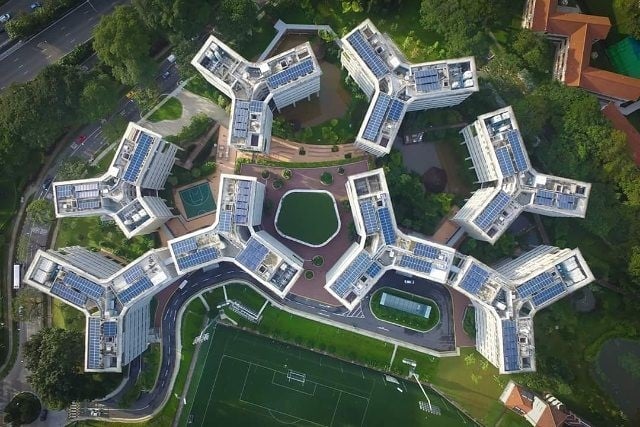Click here for our final presentation slides.
Thank you!
Click here for our final presentation slides.
Thank you!
One of the biggest concerns for our installation is how the whole system operates and how to ensure safety of the passengers . We came up with the concept of locking the boat in place at the platform when passengers are embarking and disembarking by stopping the pulley system. There are two buttons used, one on the platform and another on the side of the boat. These info-graphics show how it works.
Below are some renderings after added design and modification.

Lastly, we placed the installation on the screenshot of the map of Nanyang Lake. To make the trip more interesting and provide passengers more view of the surrounding, we decided to create a slightly longer distance (70 meters).
Besides, we are also considering on which design to adopt to make the gate/entrance to the pedal boat more visible.
In order to better develop the design for the pedal boat, we went to Sports Hub for a field trip to experience the ride.
Below is the image of the boat that we took, which allowed 2 people to pedal at the same time. The shelter was very simple and it was still very bright and hot when in the boat.



^ Close-up photos of the pedal as well as a simple 3-way control of the direction. (L-left, straightforward, R-right)
v Two propellers at the bottom of the boat to move the boat forward. We were told not to pedal in reverse as it would harm the mechanism. 

 There was a simple mechanism that allowed the user to move the seat forward and backward to find a comfortable distance.
There was a simple mechanism that allowed the user to move the seat forward and backward to find a comfortable distance.
We also tested on how the boat can make a U-turn and here is a video on it:
The boat wouldn’t be stuck but could turn even at a very close distance to the floating ball as long as we pedaled.
We also looked at the different platform on land and floating and considered what possible solutions could be used for our design.
Overall, what we concluded from this field trips are:
The boat moves at a very slow speed and it was quite exhausting to move around in the lake in sports hub and thus we felt that the size of nanyang lake is just nice for a casual and relaxing ride.
The boat could get stuck when moved near plants in the water therefore causing unnecessary trouble. This issue would be resolved if the boats are tied to a pulley system on a fixed route.
The shelter needs to be more further developed so that it works better to shed the sunlight. The material needs to be more durable as well to withstand the weather.
The pedal seat didn’t allow adjustment to the inclination of the seat and it could have provided better back rest.
…
Besides, we also measured some dimensions of both the exterior and interior of the boats, which could be used in the following process when we go into detailing of our design.
We will develop our design based on observations made from the field trip and also implement an interactive feature into the boat system.
Continuing from previous posts and feedback from the class, we decided to further develop the concept of a pedal boat, which incorporates the idea of team cooperation and provides a shelter for people to sit and enjoy the view of the lake.
Some concerns about this concept were:
1. What if some one pushes the boat away from the platform
2. The circumference of the ride would take up too much area of the lake
3. The connection below water might disrupt the natural environment
Therefore, we came up with the idea of implementing a pulley system into the concept.
Two boats would be tied with ropes that suspend above the water to avoid disturbance of the environment. Besides, the boats can only be moved when people sit on it and pedal. There are platforms installed at both sides of the lake to provider easy access. Similarly there are solar panels installed on top of the boat to provide light at night. Besides, two fixed pulley component in the lake also have solar panel and lights on the top surface.
Below it’s a video showing how the installation works:
The boat can be constructed using existing pedalo and we modify it by add more comfortable back support as well as a nicer and durable shelter. In terms of the rope, we are considering buying steel cable with Teflon coating as it is durable, waterproof and sufficient to withstand the force needed.
In addition we also looked at some different projects that aimed at revitalization of a location that was forgotten over time.
1. Swing Time

It’s a very simple yet interesting concept of a ring shape swing that emits light and changes color when people sit and use it.
2. Pop Rock

3. ParKIT

All the projects above are different approaches artists take to bring attention to a mundane or ‘boring’ places. There are all site-specific as they are not too obtrusive and out of the place, yet they create a comfortable environment with some surprising elements for people. Thus, people will go and spend time in the places.
Other references
Interesting water bike!
We will then focus on developing the form of the pedalo to make sure it fits in nicely with the surrounding and provide a comfortable ride experience for the people.
Based on the concept of Nantah spirit of team work and feedback from last week’s presentation, we went on to explore more about the space, especially focusing on the essential element, the Nanyang Lake.
The photo below provides a clearer view of the lake and surroundings:
The narrow pathway embracing the lake, and the benches are all exposed to the scorching sunlight during the day. At night time the place is dark and quite. Despite the peaceful and nice natural environment, people seldom visit the place.
Our concepts will incorporate the element of play and team spirit to create an installation that is site-specific and provide an attraction for people.
Inspiration – Water Game
 There are various types of water games where people cooperate and play. Most of these installations are made of inflatable materials and require high level of sport involvement. Among all these, the concept of a water roller and pedal boats seems pretty interesting.
There are various types of water games where people cooperate and play. Most of these installations are made of inflatable materials and require high level of sport involvement. Among all these, the concept of a water roller and pedal boats seems pretty interesting.
Inspiration – Bridge
Bridges would also fit nicely as suggested in last week’s class. There are many fascinating bridge designs that inspire our design as well.
https://www.archdaily.com/543458/friedrich-bayer-bridge-loebcapote-arquitetura-e-urbanismo
This is a bridge with two halves that rotate to join or separate. The design allows canal navigability. Below it’s a kinetic bridge with the similar purpose. The design is iconic and dramatic.
https://mymodernmet.com/knight-architects-akt-ii-merchant-square-footbridge/
http://www.mostamazingplaces.net/some-unusual-bridges-in-the-world/
Unlike many bridges that broke into two, this bridge is unique in the way that it closed itself up into one piece.
Concept 1
The design is a shelter with seats and pedals of two directions installed.With the fixed track in the water, the shelter allows people to sit under it and step on the pedals/ cycle. The whole shelter will then move towards the direction. More people stepping, it will move faster. They can use it like a bridge to cross the lake, or just seat and relax in the middle.
At night, the shelter will be lit up using power generated from the solar panel installed on top of it, providing a nice reflection on the water.
Concept 2
This concept is just slightly different from the previous one. Instead of moving in a straight manner, there are two shelters attached at two ends of the installation. The shelters will then rotate around the centre and transporting people to cross the lake.
Following the part one on research posted by Matthew: https://oss.adm.ntu.edu.sg/mong017/2018/02/07/chen-yue-matthew-week-4-part-1/http://click here
We came up with the idea of incorporating a see-saw into our design as it requires at least two people to cooperate to play. This represents the Nantah spirit of teamwork and it would also bring some fun element into the area where this installation would be placed.
Firstly we did some explorations of the form of see-saw. One of the inspiration came from the honey bees. These are great team players and creatures with perseverance. We thought about using the electricity generated from the usage of the see-saw to power lights that can be used at night.
After consultation with Prof Fabrizio & Ker Siang, we did some more research , discussed and decided to focus our designs on this direction:
Bringing comfort and coziness with the installation to attract people to go to Nanyang lake, creating a sense of belonging
Below are some explorations of what the installation could be to provide a comfortable surroundings for people to spend some time in the Nanyang lake area. There are translucent plastic strips to keep out the heat from the sun and rain to act as a shelter, which will also create dynamic visual movement when two people sit and play on the see-saw installed beneath. Shelter with solar panel could harness power to provide light during the night time, which will also reflect on the lake surface, bringing more attention to this location.
One idea was to build a small elevating platform as shown in the above image, where people can sit or lie down in a more relaxed posture to enjoy the surroundings. The other concept tied in with the see-saw that provide stillness for one individual user but become fun and dynamic when two people sit on it.
The article ” The Infra-Ordinary ” by Georges Perec raised many questions on the ordinary and mundane things that happen almost everywhere everyday. We are so familiar with them that we stop noticing. Perec encouraged people to ask questions about daily things and challenge the ordinary. It’s only when we think about it that we realize how little we actually know and how much information is just being neglected by us.
With this realization, we started to think about our daily life in NTU and began to obtain more observation. During our discussion, this photo below that caught our attention.

It was the icon of NTU pioneer hall on the wall as shown in this photo. It resembled a bone icon but actually it derived from the top view of the Pioneer hall cluster.

It was quite shocking to find out this interesting fact about pioneer hall. Even though we rely highly on our sight to navigate around places, there were still many things that we overlooked.
We decided to create a sculpture to describe many mundane details of this place. An experience of the pioneer hall was composed of not just the visual but many other senses. According to this article (https://velvetchainsaw.com/2012/05/23/your-senses-your-raw-information-learning-portals/), the percentage of senses we reply were as followed:
83.0% – Sight
11.0% – Hearing
03.5% – Smell
01.5% – Touch
01.0% – Taste
For this experience sculpture, there were three blocks, in the shape of the building icon. With varying heights, each represented the following senses: hearing, smell and touch. The tallest one contained dry tree leaves to create the sound of tree branches. The following had a smell of coffee, representing the canteen experience and lastly, the lowest one provided touch that simulated the texture of the walls in the pioneer hall.